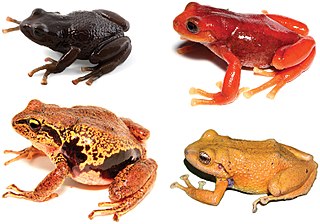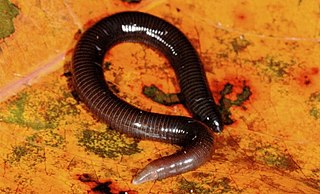
Sooglossidae, the Seychelles frogs or Seychelles Island frogs, are a family of frogs found on the Seychelles Islands. Until recently, this family was believed to include the genera Sechellophryne, Nesomantis and Sooglossus, but following a major revision of amphibians in 2006, the genus Nesomantis was named a junior synonym of Sooglossus. Their closest relatives are the purple frogs (Nasikabatrachidae) of India.

Pseudemys is a genus of large, herbivorous, freshwater turtles of the eastern United States and adjacent northeast Mexico. They are often referred to as cooters, which stems from kuta, the word for turtle in the Bambara and Malinké languages, brought to America by enslaved people from Africa.

Sternotherus is a genus of turtles in the family Kinosternidae including six species commonly known as musk turtles. The genus is endemic to North America, occurring in the eastern third of the USA and southeast Ontario, Canada. Musk glands positioned near the bridge of the shell can produce fowl smelling secretions when the turtles are threatened, although genital handling does not normally provoke a response. Sternotherus are moderately small turtles, with the largest species in the genus, the razor-backed musk turtle, attaining a maximum of 17.6 cm. in shell length. The carapace is characteristically oval and domed, with most species having one or three keels on the back which may become smoother and obscure with age in some species. Musk turtles are generally drab in color, mostly black, gray, brown, olive, or ocher, which aid in camouflaging them in their natural habitats. The head is relatively large and stout, marked with spots, streaks, or strips. The plastron has only 10 or 11 scutes, as opposed to 12, a more common condition in North American turtles. The tail is short, with males having a horny claw like tip.

Bokermannohyla is a genus of frogs in the family Hylidae. It was erected in 2005 following a major revision of the Hylidae. Twenty-three species previously placed in the genus Hyla were moved to this genus named in honor of Werner Carl August Bokermann, Brazilian herpetologist. The genus is endemic to southern Brazil.
Hypogeophis brevis is a species of caecilian formerly included in the genus Grandisonia and found on the islands of Mahé and Silhouette in the Seychelles. It is known only from two specimens collected on Mahé in 1910 and more collected recently from Silhouette.
The Makumunu Assumbo caecilian, Idiocranium russeli, is a species of African caecilian in the family Grandisoniidae. It is one of the smallest of caecilians, and is found in Cameroon. It is monotypic in the genus Idiocranium.
Praslinia cooperi, or Cooper's black caecilian, is a species of caecilian in the family Grandisoniidae. It is monotypic in the genus Praslinia. It is found on Mahé and Silhouette Islands in the Seychelles. An old reported sighting on its namesake Praslin is not known to be correct.
Grandisonia alternans is a species of caecilian in the family Indotyphlidae, endemic to the Seychelles islands of Mahé, Praslin, Frégate, and La Digue.
Grandisonia larvata is a species of caecilian in the family Indotyphlidae, endemic to the Seychelles islands of Mahé, Praslin, La Digue, and Silhouette.
Grandisonia sechellensis is a species of caecilian in the family Indotyphlidae. It is endemic to the Seychelles islands of Mahé, Praslin, and Silhouette.
Sylvacaecilia is a monotypic genus of caecilian in the family Grandisoniidae. The only species is Sylvacaecilia grandisonae, also known as the Aleku caecilian or Ethiopian caecilian. It is endemic to southwestern Ethiopia and known from the Gambela, Oromia, and Southern Nations, Nationalities, and Peoples' Regions.
Batrachosaurus is an extinct genus of prehistoric brachyopoid amphibian that lived in Germany during the Middle Triassic (Ladinian). The genus was named by Joseph Fitzinger in 1837 and the type species, B. jaegeri, was named three years later in 1840. It may have been the same animal as Mastodonsaurus.
Erythrobatrachus is an extinct genus of trematosaurian temnospondyl within the family Trematosauridae. The sole species Erythrobatrachus noonkanbahensis was separated to a monotypic genus, distinguishing it from related taxa when the description was published in 1972. The type material was a matrix cast revealing the impression of several fragments of skull excavated at the Blina Shale formation in the northwest of the Australian continent. The genus name is derived from ancient Greek, combining terms for red, erythro, with frog, batrachos, to describe the iron staining of the fossilised amphibian specimens. The type location described by the specific epithet was Noonkanbah Station.
Thabanchuia is an extinct genus of dvinosaurian temnospondyl within the family Tupilakosauridae. It is known from the Lystrosaurus Assemblage Zone in Thaba N'chu, Free State, South Africa. The genus contains just one species, Thabanchuia oomie, the type species.
Gegeneophis is a genus of amphibians in the family Grandisoniidae. They are found in southern and northeastern India.
Indotyphlus is a small genus of caecilians in the family Grandisoniidae. As caecilians in general, they superficially resemble earthworms. The genus is endemic to the Western Ghats, India. They are sometimes known as Battersby's caecilians.

Craugastoridae, commonly known as fleshbelly frogs, is a family of New World direct-developing frogs. As delineated here, following the Amphibian Species of the World, it contains 123 species. They are found from the southern United States southwards to Central and South America.
The Grandisoniidae are a family of common caecilians found in Africa, Seychelles and India. Like other caecilians, they superficially resemble worms or snakes. The family was formerly known as Indotyphlidae.

Hypogeophis is a genus of caecilians in the family Grandisoniidae. The genus consists of four species, all endemic to parts of the Seychelles Archipelago.

Darrel Richmond Frost is an American herpetologist and systematist. He was previously head curator of herpetology at the American Museum of Natural History, as well as president of both the Society for the Study of Amphibians and Reptiles (1998) and the American Society of Ichthyologists and Herpetologists (2006). Four taxa are named in his honor: the toad genus Frostius, the tree frog Dendropsophus frosti, Darrel's chorus frog Microhyla darreli, and Frost's arboreal alligator lizard Abronia frosti.






